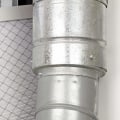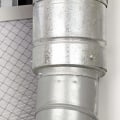For this, the Centers for Disease Control and Prevention (CDC) recommends a Minimum Efficiency Reporting Value (MERV) of 13 or higher. This is more than enough to block droplets and dust at least a few microns in diameter. But does a MERV 13 filter meet your needs when it comes to protecting against the novel coronavirus?A MERV 13 filter is a step in the right direction and captures more particulates than a typical MERV 8 filter. However, it is not as effective at capturing small particles the size of a virus as a High Efficiency Particulate Air (HEPA) filter does.
A MERV 13 will trap less than 75% of air particles that are 0.3 to 1.0 microns in size (the coronavirus is 0.1 microns).It is also difficult for many existing HVAC (heating, ventilation and air conditioning) systems to adopt a MERV 13 due to the increased load on the fan by the finer filter media, which can actually cause more harm than good, as well as reduce airflow if your system is not designed to handle that type of filter. On average, many installations are limited to one type of MERV 8 or MERV 9 filter. RP Fedder sells a full range of MERV 13+ filters and can help you determine what types of filters and efficiency ratings you need. A HEPA filter is essentially the ultimate solution in the air cleaner world and far surpasses what a MERV 13 can do. So how did we do in our tests with our “Box Fan” with a MERV 13 filter cleaning device? In the tool room, the device removed 59.7% of one-micron particles and 86.4% of five-micron particles. For HVAC systems, ASHRAE recommends a filter with a minimum MERV rating of 13, but MERV 14 or higher is preferred. Using a 4″ MERV 13 filter instead of a 1″ filter reduces drag and increases flow from 320 fpm to 460 fpm.
MERV 16 is the tallest filter you can buy, but your air conditioning system may not be able to handle it. MERV 13 and above could be used as a final filter in clean rooms, surgical rooms, inpatient care, and smoking rooms. The Minimum Efficiency Reporting Value (MERV) is an effectiveness scale for air filters that was developed by ASHRAE in 1987. Therefore, a good option to increase performance and preserve the engine of the “Box fan with a MERV 13″ air filter is to go to a filter 4.MERV 1 is classified as a filter that can only capture less than 20% of particles less than 10 microns wide. Alternatively, you can upgrade the ventilation system itself, making it suitable for at least MERV 13 filters. One way to measure the resistance and also the performance of the “Box Fan with MERV 13″ filter device is to measure the air flow. Therefore, using a high merv filter to purify the air of COVID-19 can help reduce the spread in the office environment.
MERV 14 and above can capture particles that are even smaller than previous MERV ratings, ranging from 0.3 to 1.0 microns in size.






